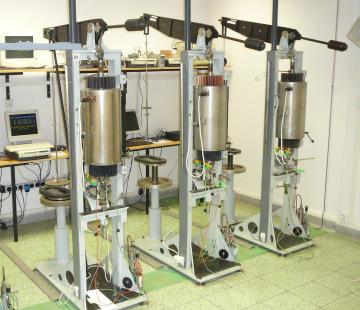Institute of Physics of Materials AS CR, v. v. i. > List of facilities > Creep machines - our own design

In all tests - possibility of protective atmosphere: purified dry argon, hydrogen, nitrogen
Testing temperatures:
R.T., 70 - 950 °C, constant within:
1 K for 70 - 600 °C
2 K for 600 - 950 °C
Temperature gradient along the whole 50 mm gauge length - lower than 2 K
Elongation detection:
continuous analog and digital recording
range of creep rates: 10-10 to 10-2 s-1
registration of data - PROGRAM CRTES1 (developed in IPM)
Creep curves processing:
fitting by standard constitutive equations; statistical assessment of long-term properties.
Other options
Creep machines - our own design
| Contact | Ing. Petr Dymáček, Ph.D. |

35 creep machines of our own construction allowing tests up to 950°C and various loading modes.
In all tests - possibility of protective atmosphere: purified dry argon, hydrogen, nitrogen.
35 creep machines of own construction allowing (alternatively):
- constant tensile load tests
- max. load 8000 N
- max. strain 0.60 (0.47 true) (at 50 mm gauge length)
- constant tensile stress tests
(Hostinský and Čadek, J. Test. Eval. 4, 1976, p. 26) - specimen gauge lengths 25, 35 and 50 mm
- max. initial load 8000 N
- max. strain 0.42 (0.35 true)
- constant compressive stress tests (only 5 machines)
( Dobeš et al., J. Test. Eval. 14, 1986, p. 271) - specimen gauge lengths 7.5, 12, 15 mm
- max. load 8000 N
- max. strain 0.32 (0.28 true)
- constant tensile stress (or load) with a possibility of rapid cooling under stress at a predetermined time of creep exposure - see a) or b) - three machines
- e. small punch tests – SPT (three machines identical with sub d)
ceramic ball penetrated through a thin disk under: - a given force, central deflection of the disc is measured – analogy with creep tests
- constant rate of deflection, acting force is measured – analogy with stress–strain tests.
In all tests - possibility of protective atmosphere: purified dry argon, hydrogen, nitrogen
Testing temperatures:
R.T., 70 - 950 °C, constant within:
1 K for 70 - 600 °C
2 K for 600 - 950 °C
Temperature gradient along the whole 50 mm gauge length - lower than 2 K
Elongation detection:
continuous analog and digital recording
range of creep rates: 10-10 to 10-2 s-1
registration of data - PROGRAM CRTES1 (developed in IPM)
Creep curves processing:
fitting by standard constitutive equations; statistical assessment of long-term properties.
Other options
- Possibility of recording of creep tests with varying applied stress:
- computer treated creep dip tests,
- tests with slow applied stress cycling
- Possibility to perform stress–strain tests (in tension as well as in compression) at constant crosshead velocity at all temperatures and in protective atmospheres (on three creep machines)


